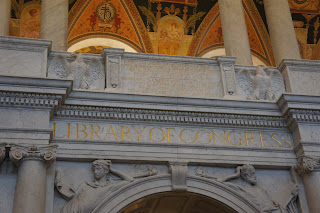A couple of weeks ago (September 25th-28th) I was back in D.C. for work. I needed to be in the office there on the 27th and 28th and my original plan was to fly out on Monday. Since going to the east coast requires a full day of travel, Monday would have been a lost day of work anyway. So, I decided to take the last AA direct flight to DCA on Sunday so I could have a day of sightseeing on Monday. I stayed in Capitol Hill, so hung around that area for the day.
I started the day with a tour of the U.S. Capitol.
The tour began in Emancipation Hall which is named to recognize the contributions of enslaved laborers who helped build the U.S. Capitol.
The statue of Eusebio Francisco Kino (Arizona) located in Emancipation Hall. He led exploratory expeditions to Mexico and lower California and worked with Pima Indians in Southern Arizona, and also built missions, ranches, and roads in California and Arizona.
I learned on the tour that each state is allowed to have two statues in the U.S. Capitol. The other AZ statue is located in the old hall of the House of Representatives and is pictured below in this blog post.
This is the original plaster model for the bronze Statue of Freedom atop the Capitol Dome. This model is 19.5 feet tall and weighs approximately 13,000 pounds. In 1857, Thomas Crawford, an American sculptor working in Rome, completed the plaster model for the Statue of Freedom. After Crawford's death, another American sculptor, Clark Mills, was hired to cast the statue at his foundry in the District of Columbia. When the worker who had put the plaster model together refused to disassemble it unless his unreasonable demands for extra pay were met, Philip Reid, an enslaved craftsman owned by Clark Mills, determined how to separate the sections so they could be moved to the foundry for casting. At the foundry, Reid was put in charge of keeping the fire going under the molds, and he worked with other enslaved laborers as the sections of the plaster model were cast into bronze. Philip Reid was emancipated shortly before the completed bronze statue was moved to the Capitol Grounds in 1862, and he was a free man when the last piece was put in place on the Dome on December 2, 1863. This model, which had been stored in pieces for many years, was restored in 1992.
This is the "center" of what is known to the locals as "The District." This is located in the crypt of the U.S. Capitol, and it is called the crypt because the original intent was that it would be the final resting place of George Washington. However he died years before the Capitol was completed and when this was finished his family did not want to move his remains from Mount Vernon.
Looking at the Capitol Dome from the Rotunda.
The Rotunda, a ceremonial space where state funerals have been held since the time of Abraham Lincoln, for presidents, members of Congress and military heroes.
The original House of Representatives room.
The statue of Barry Goldwater, which is the other AZ statue located in the Capitol.
We walked by Paul Ryan's office in the Capitol.
After the Capitol tour, I took the underground tunnel to the Library of Congress.
The Library of Congress was established in 1800, when President John Adams signed a bill transferring the seat of the U.S. government to Washington. The initial collection of 740 books and 3 maps was housed in the new Capitol Building until August 1814, when invading British troops burned the building, destroying the library.
President Thomas Jefferson offered his personal library as a replacement. In January 1815, Congress appropriated $23,950 to purchase Jefferson's collection of 6,487 books, and thereby laid the foundation for a great national library.
Facing a shortage of space in the Capitol and concerned about the safety of the collection after two disastrous fires, Congress approved the construction of a separate building for its Library.
The Library of Congress today is the world's largest repository of knowledge and creativity, with a growing collection of more than 162 million items, including books, print materials, sound recordings, photographs, maps, sheet music, motion pictures, and manuscripts in more than 470 languages.
After the Library of Congress, I walked to the House of Representatives Offices to get tickets to go into the House and Senate as they were both in session. The House was already in session when I arrived, so stayed and listened for about 10 minutes. I got to the Senate Gallery about 10 minutes before they went into session for the day, so was able to watch the beginning. We said the pledge of allegiance and the Senate chaplain prayed prior to starting. I have no photos or videos to prove I was actually there as there were 3 rounds of security to even get into the Senate or House, at which phones and cameras were taken away.
By the time I was done with all the tours it was time for a late lunch. I have been following Sweetgreen on Instagram and knew there was one in Capitol Hill, not far from where I was at. So, did lunch there before heading up to Tyson's Corner to begin my work responsibilities.






























No comments:
Post a Comment